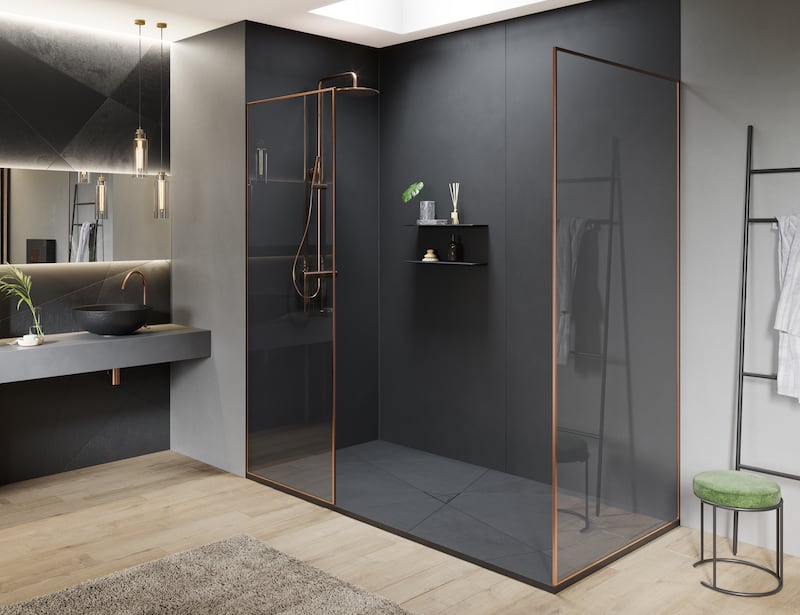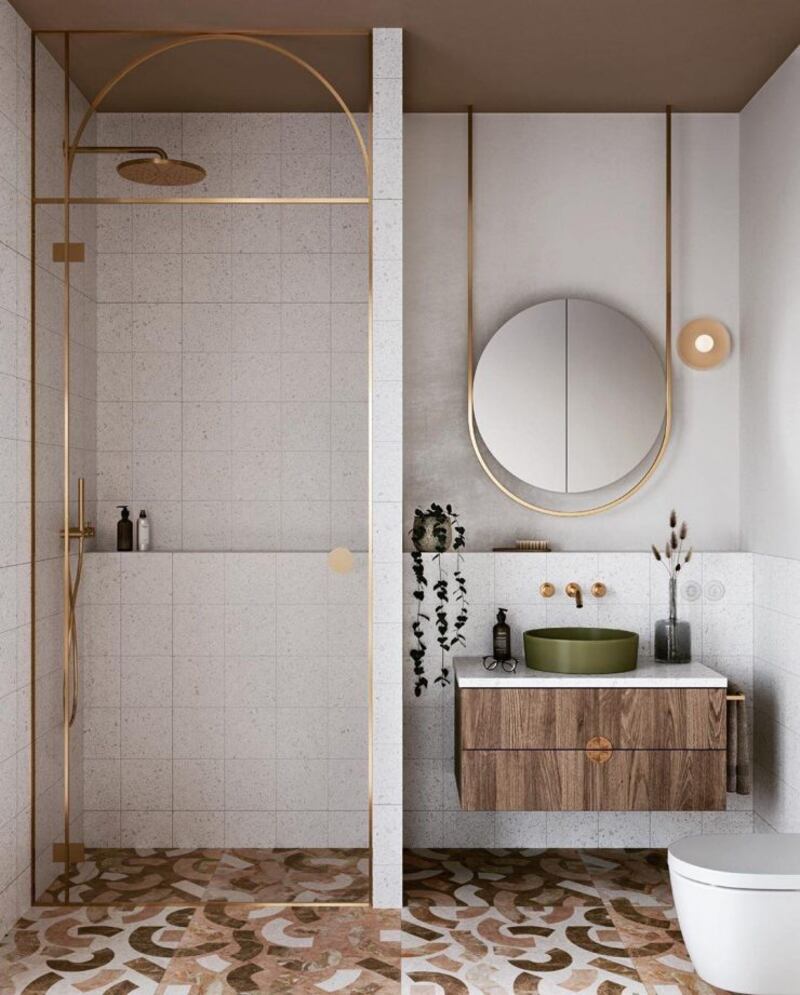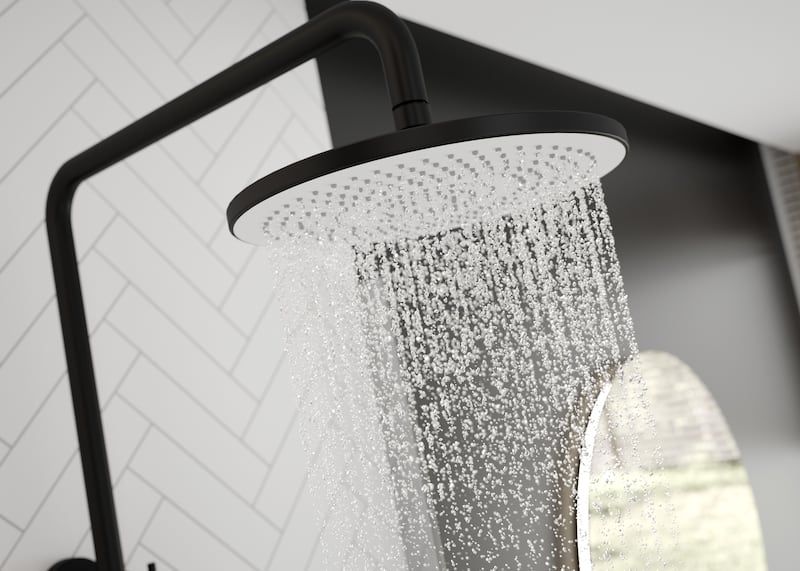Maybe it’s in the eyes of the hardware shop assistant as they hand over two tins of damp-stain blocker for your kitchen ceiling. Maybe it’s in the seemingly sudden sponginess of the shower wall, or the ominous gunk that has colonised the corners of the enclosure. Perhaps you have inherited a previous homeowner’s style and only now have got around to putting your own stamp on the bathroom. Perhaps your needs have changed: you require a more accessible layout; you want a bath for a baby, or a shower seat for older or younger family members; or you need an extra bathroom because your offspring have changed their showering habits from twice a week to twice a day.
The big picture
First off, have a good hard look at your bathroom and think about how it works for you. Taking photographs will help you see it through fresh eyes. Ask everyone else who uses it what they like and hate about it, what they’d keep and what they’d replace. Is the bathroom in a busy part of the house where having double basins for toothbrushing would ease morning hassles? Do you want to walk into the shower, or would you prefer an enclosure? Could you turn a little-used boxroom into an en suite? Has anyone apart from the dog used the bath in the past year?
“Think about who is going to be using the new bathroom, says Shane O’Halloran of Ripples Bathrooms in Dublin 12. “Do you need to future-proof it; does need to be a child-friendly, family bathroom or is it an adult-only space to relax in?”
“Go to a showroom, and ignore your budget first,” says Derek Keeley, national sales director of Sonas at Ballycoolin, which supplies individuals, shops and developers. “Look at everything and decide what you like and what will fit the space.” Then get a quote and do some value-engineering from there on: “Splurge on what’s important – a big shower, a double vanity unit, or whatever – and be mindful about the rest, swapping some items for more budget-friendly pieces,” he says. “You should have a realistic budget, as the cheapest option isn’t always the best,” says Tracey Corboy of Infinity Bathrooms.
RM Block

Consider the style and theme you want, as well as how your new layout and materials will work for you, says O’Halloran. “Consider factors such as durability, maintenance and cost when selecting flooring, tiles, countertops and cabinetry. Look at your daily routine, budget, how much storage is needed and so on.”
Inspiration
Seek ideas and recommendations from friends and neighbours. If you see a van outside a house, you probably wouldn’t ask the homeowner to let you have a peek, but you can note the company’s details and look them up when you get home. Don’t be afraid to ask retailers for references, or to put you in touch with previous customers.
There are endless sources of inspiration, from home-decoration and design magazines to the particularly addictive Instagram and Pinterest pages and other social media. Once you’ve looked at a few interior design, renovation, self-build or bathroom inspo accounts, many more will flood into your feed. Architects’ and interior designers’ websites show their work in the coherent context of a home, and it’s always worth keeping an eye on sites such as myhome.ie to see inside second-hand and new-build properties.

Bathroom retailers also have an online presence: Tilestyle, in addition to its vast showroom at Ballymount Retail Centre has a comprehensive website with a host of blog posts on everything from its design collaborations to advice on bathroom layouts to maintaining your floor. Bathhouse in Monkstown has an excellent online portfolio to complement its well-stocked showroom, and Ideal Bathrooms in Ballymount has a useful online guide to fixtures and products. These retailers will recommend fitters.
Know your limits
If you’re planning a wetroom shower, consider where your underfloor waste/outflow pipes lie, and whether you will be able to adjust them. If they are high and can’t be lowered, you may not be able to install a wetroom floor but will have to use a tray; these come in a variety of materials, dimensions and finishes. If you have built an extension, your soil pipe might be concealed and inaccessible within the interior wall. Of course, your fitter might not know this until they take up the old floor, so they will have to cost for both options and, depending on the supplier, you might be stuck with extra tiles.
You also need to look at your water pressure to see what kind of shower will work, says Keeley. And look at the location of your water pipes; it might be possible to have the shower valves outside the enclosure so you could let the water heat up before you step in.
Lighting and ventilation
Consider this carefully at the start. Do you want soft light for during the night and a bright light for shaving or applying make-up? Would you like a mirror cabinet with integrated light? Can you open the window easily, and could you do with a better fan? And, seeing as you’re taking the whole room apart, Corboy recommends insulating outside walls; it’ll take up a little floor space but will add to the comfort.

Space and storage
Make everything work very hard; a towel rail can run off electricity or can double up as a radiator if it’s connected to the heating system; a vanity unit with drawers can hold anything from make-up to cleaning products and spare toilet rolls, and won’t take up much more space than a regular basin on a pedestal; a mirrored cabinet will store toothbrushes and razors and some also have integrated lights and Bluetooth speakers (though bear in mind some bathers might take up permanent residence).
Wall-hung vanity units and toilets are good in smaller bathrooms and are easier to clean around. Bear in mind that toilets come in different heights, so sit on them in the showroom.
Timing
What is the lead time on materials? When does it suit you, and when does the fitter have a slot? Given that a renovation should take seven to nine working days, how will you manage if you are doing up your only bathroom? Could you stay with a relative? Can you shower at work, in a gym or at your neighbour’s house? Perhaps you could time the work to coincide with a holiday, but then you risk the fitter calling you every day to check details or report problems, or returning to find things are not as you had expected.
Sustainability
Rather than dumping old fixtures, it’s worth finding out whether you could sell, recycle or donate a perfectly good bath, a vintage sink or a statement mirror that might suit someone else if it is not going to work with your new design. You can donate through local freecycling sites, or advertise online, and big recycling centres take flat glass shower screens and mirrors as well as metal.

The dos and don’ts of bathroom renovation
Do set a budget. Seek quotes from a few providers, both all-in and supplier-only. Remember VAT is charged at 23 per cent on products and 13.5 per cent on labour. If you require an accessible bathroom, see if you qualify for the Housing Adaptation Grant for People with a Disability scheme, which is administered by local authorities and gives financial aid for home modifications up to a maximum of €30,000.
Do ask for a consultation. Some companies will send a person to measure up, and with their experienced eye will be able to tell immediately whether your dreams are feasible or unreasonable. For example, they might suggest rehanging the door to accommodate a bigger shower tray; or they might say you could put the shower along that outside wall but you’ll have to replace the wooden window. As a follow-up, some companies will use special software to create a 3D layout of your room, based on your discussions. If you are keen on a supplier or fitter but find yourself chasing them for a quote, think about whether they are right for you: you don’t want to be chasing them to come and fix a leak.
Do compromise and be flexible. If you really love something you’ve seen in a magazine or online, but your fitter or provider advises strongly against it, listen to them. It’s easy to be seduced, for example, by a beautiful matte-finish bowl-basin sitting on a wooden ledge, but unless it’s for a rarely used guest en suite, there will be streaks on the bowl and the base is going to be spoiled with soggy circles.
Do check colours. If you’re going to follow colour trends, heed Corboy’s advice to check the colour of sanitary ware and fittings such as vanity units really carefully, as they can look very different in a showroom from when they are fitted in your home. She also recommends using large-format tiles, as there will be fewer grout lines and they give the illusion of more space. Use dark grout on floors and light grout on walls, says Corboy: do not use mosaic or small tiles in showers as the grout will get dirty very quickly. She also cautions ensuring the tiler respects the pattern, so you don’t get an ugly join in a marble seam or an upside-down grain that will trap soapy run-off. Tiles cannot be unfixed.
Don’t forget what’s important to you. When you walk into the big shiny showroom: observe whether the retailer listens to your requirements and constraints, and whether they frown at your existing set-up or come up with creative solutions. There’s nothing more annoying than telling someone in a showroom that six people shower every day and need to hang and store their towels, only to be shown a tiny hotel-style rack that apparently works perfectly well for most people.
Don’t fall for sales patter: Never let a salesperson talk you into buying something you don’t like or that isn’t practical for you. If you’re wearing silver jewellery and tell them you like only chrome fittings, don’t be seduced by their trendy brushed-finish rose-gold brassware or black Crittal-style shower screen. If you love the look of a shower control but you can’t twist it even when it’s dry, it won’t work for you. If you stand in the showroom shower and can’t extend your elbows to wash your hair in comfort, you need a wider enclosure. If you really want a drench showerhead, but you don’t wash your hair every day, you will need a dual shower with a second, hand-held unit mounted on a rail or wall. (This will also be useful for cleaning.)
Don’t change your layout. Once work gets under way stick with the plan. It will cost extra time and money, and annoy your fitter beyond reason. For example, says Keeley, “You can’t add in shower alcoves once it is tiled. That’s one of the decisions that need to be made in the initial stages.”

Bathroom trends
The first thing about trends, says Shane O’Halloran of Ripples, is not to get caught up in them. “Creating an on-trend bathroom that won’t date is always tricky,” he says. Plus, as you’d hope to be using this bathroom for at least 10 years, it’s a big commitment to something if you are not entirely sold on it, or if you tire of it after a short time. He usually advises “taking some elements of the current trends, but toning them down slightly; perhaps you could use timeless bathroom furniture and sanitary ware and incorporate your preferred trend through blinds, towels and accessories. These factors will also help you stay within your budget,” he says.
Spa bathrooms are very popular at the moment, with elements including free-standing, whirlpool and extra-deep baths, wetroom showers, low lighting and humidity-loving plants. Always request a waterproof tanking membrane in the shower area, says Tracey Corboy of Infinity Bathrooms, and put underfloor heating in the rest of the room; it will cost from about €350 to install, and is cheap to run. As well as feeling very nice underfoot, it will help to air the room and towels more quickly.
Fluted finishes such as reeded tiles and scalloped sinks, and tiles in patterns such as herringbone or chevron, crayon and hexagon are really popular. Be warned, though, that some of these layouts can add a lot to the cost because there is more cutting and wastage involved, and they also need more joins.
Corboy says colour is popular in vanity units, radiators and shower trays – some of which can be customised with RAL colours – and popular brassware finishes include brushed nickel and warm bronze.
O’Halloran sees a turn towards bronze brassware as well as terracotta tones including warm browns, golden yellow, orange, and pink. Keeley says chrome is still his best seller, and people like to have all bathroom hardware matching, from taps to shower fittings to accessories.




















